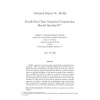Free Online Productivity Tools
i2Speak
i2Symbol
i2OCR
iTex2Img
iWeb2Print
iWeb2Shot
i2Type
iPdf2Split
iPdf2Merge
i2Bopomofo
i2Arabic
i2Style
i2Image
i2PDF
iLatex2Rtf
Sci2ools
79
Voted
ITCC
2000
IEEE
2000
IEEE
Parallel Real-Time Numerical Computation: Beyond Speedup III
Parallel computers can do more than simply speed up sequential computations. They are capable of nding solutions that are far better in quality than those obtained by sequential computers. This fact is demonstrated by analyzing sequential and parallel solutions to numerical problems in a real-time paradigm. In this setting, numerical data required to solve a problem are received as input by a computer system, at regular intervals. The computer must process its inputs as soon as they arrive. It must also produce its outputs at regular intervals, as soon as they are available. We show that for some real-time numerical problems a parallel computer can deliver a solution that is signi cantly more accurate than when computed by a sequential computer. Similar results were derived recently in the areas of real-time optimization and real-time cryptography. Key words and phrases: Parallelism, real-time computation, numerical analysis. This research was supported by the Natural Sciences and En...
| Added | 31 Jul 2010 |
| Updated | 31 Jul 2010 |
| Type | Conference |
| Year | 2000 |
| Where | ITCC |
| Authors | Selim G. Akl, Stefan D. Bruda |
Comments (0)

